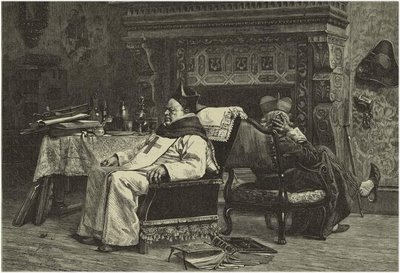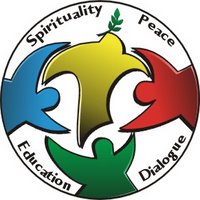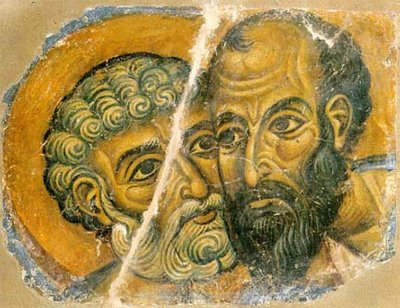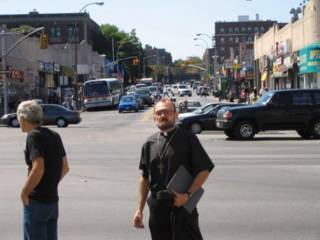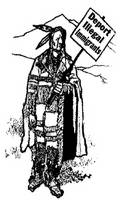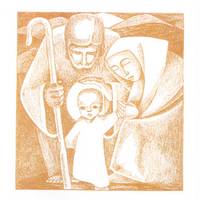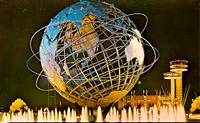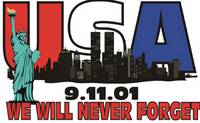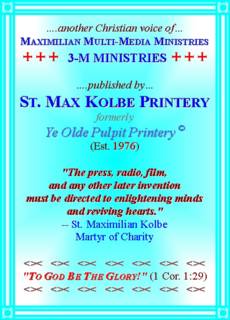Old Catholic and Anglican Prelates Gear Up for 2nd Pan-Ecumenical Conference PENDING THIS FALL
Historical: North American Old Catholic "ecumenical dialogue"
(1875 Print entitled "A Schism", by J.G. Vierey in Brooklyn, NY. Borrowed from the "NY Art Journal", NYC Public Library )
Plans are in the works for another pan-ecumenical conference of European and American Old Catholic bishops projected for this fall on the west coast. Last spring, on May 22-24, there was a preliminary ecumenical unity conference held here in NYC at the Bethsaida Spirituality Center in Our Lady of Lourdes Convent in Queens Village, NY which opened new ecclesial dialogues between long divided brethren.
The consultations with a select handful of American Old Catholic Bishops were jointly hosted by the Episcopal Church Office of Ecumenical and Inter-religious Affairs and the “New Age” Old Catholic Union of Utrecht which comprises the modernist Old Catholic bodies in Europe. Most other Catholics of the ultrajectine tradition belatedly learned about this introductory symposium more than a month later via e-mail.
Bishop Robert T. Fuentes -- Pastor of Holy Family Old Catholic Church in Fairfield, California (the Solano County seat) and President of the Interfaith Council of Solano County who also shepherds the Old Catholic Diocese of Napa, California -- was then chosen by his peers as the Moderator of the newly formed Conference. According to His Grace, “The purpose of the consultation was so that the Union of Utrecht could learn more of the American experience of Old Catholicism. During the consultation, both the Episcopal Church and the Union of Utrecht pledged support in fostering unity among American Old Catholics.”
The small handful of American prelates in attendance formed the core basis of the Conference of North American Old Catholic Bishops. (The website of the Apostolic Catholic Church in Tampa, Florida features some photos ot that initial conference.) This Conference patterns itself after the International Bishops' Conference and is established to foster unity among Old Catholics in the U.S. They pledged to meet at least twice a year, so that relationships among Old Catholic bishops could be strengthened and to further the work of the Conference. The next meeting of the Bishops' Conference is scheduled for November 2006 in California.
That slated meeting is limited to the SELECT initial attendees of the consultation of May 2006, who comprise the Conference, and the representatives from the Episcopal Church and the Union of Utrecht. Dr. Gunter Esser of the University of Bonn represented the Archbishop of Utrecht. Holland.
The Old Catholic Bishops joined in 1889 to form the "Union of Utrecht". They established a Bishops' Conference which meets once a year, and laid down the principles guiding communion among their Churches. At present, the Old Catholic Bishops of The Netherlands, Austria, Germany, Switzerland, the Czech Republic and Poland (the Polish Catholic Church, founded by the PNCC but now independent) are members of the International Bishops' Conference. The Archbishop of Utrecht is the ex officio chairman of the Conference but does not have any jurisdiction beyond his own diocese.
There are two other instruments of communion besides the International Bishops' Conference: the Old Catholic Congress, which meets every four years, and the annual International Theological Conference.
On July 2, 1931 the ecclesiastical Bonn Agreement was signed, sealed and delivered, establishing intercommunion (now and also known as "full communion") between the Old Catholic Churches of the Union of Utrecht and the Church of England. This full communion has since been extended to all the member Churches of the Anglican Communion, by action of the synods. This agreement reads, "(1) Each Communion recognizes the catholicity and independence of the other and maintains its own. (2) Each Communion agrees to admit members of the other Communion to participate in the Sacraments. (3) Intercommunion [in 1958 changed to Full Communion] does not require from either communion the acceptance of all doctrinal opinion, sacramental devotion, or liturgical practice characteristic of the other, but implies that each believes the other to hold all the essentials of the Christian Faith."
To monitor the progressive growing together of the two Communions, the Anglican/Old Catholic International Co-ordinating Council was established by the International Bishops' Conference and the Lambeth Conference. Its first official meeting took place in 1999.
The Episcopal Church* (having full communion with Utrecht* via the Bonn Agreement) facilitated the meeting sending Dr. Tom Ferguson--Ecumenical Officer reporting to the Presiding Bishop, and Bishop Michael Klusmeyer of the Episcopal Diocese of West Virginia, Episcopal liaison to the Union of Utrecht.
The Bishops in attendance were: +Peter Paul Brennan of New York, +Robert T. Fuentes of Napa, Califonia, +Peter Hickman of Orange County, California, and +Chuck Leigh of Tampa Bay, Florida. Also invited but unable to attend were Bishops Vince Laveri of Michigan, +Dan Gincig of Colorado and +Allen Jimenez of Louisiana.
According to Fr. Deacon Louis Souza-Fuentes, life partner and pastoral associate of the Bishop Moderator who helped coordinate the meeting, “Utrecht has decided to begin to look at the Old Catholic Church in the United States. These consultations were two years in the making and is a first attempt for the Union of Utrecht to get to know us here since the Polish National Catholic Church* based here in the United States, left the Union. The Conference of North American Old Catholic Bishops is attempting to look at ways for Old Catholics in our country to find common ground.”
The deacon outlined the following “four basic tenets” as defined and stipulated by the Utrecht as essential to their criteria of what it means to be Old Catholic. He added that “any Old Catholic bishop who subscribes to these definitions is welcome to enter into these conversations. So if you are a bishop or bishop's representative, and are interested in this endeavor -- and subscribe to the four basic tenets BELOW -- then please contact Bishop Fuentes or myself at your convenience.”
2. Apostolic Succession -- Bishops are the servants of The Church, elected by The Church, for ordained office in The Church. Succession refers to the passing on of the Faith through the laying on of hands and prayer. Succession is not the personal possession of a bishop that can be passed on to others in separation from the office of the Bishop in a local church. Just as there cannot be a bishop without a church, there cannot be a church without a bishop.
3. Theology of Communion -- The local church cannot remain alone. Its Catholicity must express itself in communion with others. Communion is a necessary consequence of being Catholic. The local Bishop stands at the intersection of this communion. The Bishop represents the local church to other churches in communion, and represents the churches in communion to the local church.
4. Synodality -- One way or translating the Greek word "Synod" is "Walking the same road together." In the local church, synodality permeates all levels of The Church. The clergy with the laity of The Church are to govern the church side by side. Old Catholic dioceses are to be governed by a synod of the clergy and the laity. The synodal structure has its roots in the early and undivided Church.
* The Polish National Catholic Church (est. in 1897) -- then the largest OC Church body in the Utrecht Union with more than 250,000 members in America and 123 parishes in the US and Canada -- left the Archbishop of Utrecht, Holland then declared that he considers the question whether women can be ordained as a matter of order and not a matter of doctrine. (That same year, various Orthodox synods also left the World Council of Churches for similar reasons.)
Coincidentally, and planned concurrently with the OC Ecumenical Conferences, a joint Polish National and Roman Catholic meeting last May made it clear that it was the full intention and desire of the PNCC to enter back into communion with the RCC in the near future. The topic of reunification will be further discussed in a joint meeting which will also be held this November.
The first woman was ordained to the priesthood in the Anglican Communion on January 25, 1944 by the bishop of Hong Kong. That was thirty years before this new practice became widespread. In 1974 eleven women were ordained to the priesthood in Philadelphia, Pennsylvania, by three retired ECUSA bishops. These ordinations were ruled "irregular" because they had been performed without the authorization of ECUSA's General Convention. Two years later, the General Convention authorized the ordination of women to the priesthood and the episcopate. The Church of England authorized the ordination of woman priests in 1992 and began ordaining them in 1994.
The first woman bishop in the Communion was +Barbara Clementine Harris, who was ordained Bishop Suffragan of Massachusetts in 1989. This year the first female Anglican primate, The Right Rev. Dr. Katharine Jefferts Schori, was elected Presiding Bishop of the Episcopal Church USA at its June 18, 2006 General Convention.
+Jefferts Schori will remain Bishop of Nevada until taking up the position of Presiding Bishop officially on November 1, 2006; her investiture and seating in the office will be held November 4 at the (Cathedral Church of SS. Peter and Paul) Washington National Cathedral. An Episcopal Presiding Bishop's term is nine years.This Holy Icon (first one above "Four Tenets"-- the second is a snapped rendition) of the apostolic brothers-in-Christ Ss. Peter & Andrew was gifted to the Roman Pontiff +Paul VI by the Ecumenical Patriarch +Athenagoras in 1964, the year they consigned the anathemas and mutual excommunications (since 1054 AD) between their respective Churches into oblivion. The icon portrays the special brotherly bond, founded in the brotherhood of the two Apostles, between the two occupants of the Sees of Peter and Andrew, between particular Churches of Rome and Constantinople which they represent, and between all Orthodox Christians and ALL Catholics regardless of their tradition.
The Church is “Catholic" because She is not confined to any one nation, place or time, teaching the same Faith as once delivered by her Divine Founder, our Lord Jesus Christ to His Apostles. "You are fortunate; you have remained in The Church through your Faith. You held fast to the foundations of The Faith which has come down to you from Apostolic Tradition... In the present crisis, it is they who have broken away from it." (St. Athanasius, champion of Christ's Divinity, Doctor of Orthodoxy, Doctor of the Church, 373 AD)
The word "Catholic" is from two Greek words, "kata holos", which means "having regard for the whole", i.e., the whole Faith and the whole Church. Rendering the word as "Universal" can be misleading if one takes that to mean "inclusive" in a sense of including things that are not consistent with Holy Tradition and Holy Scripture.


